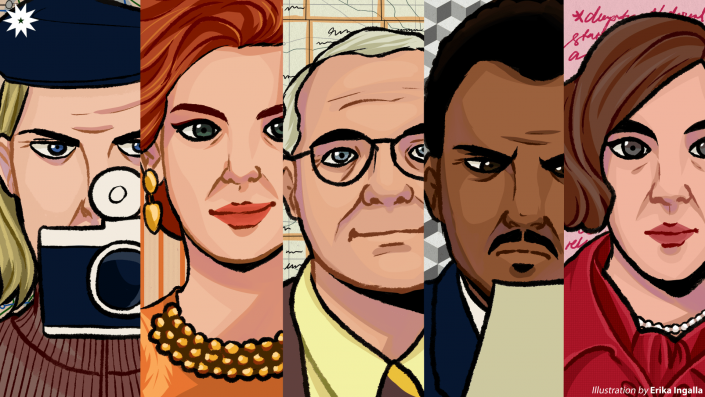Take a glance and you’ll instantly know if it’s a Wes Anderson picture.
Definitely a creator of his time, Anderson’s quirky, vivid, and youthful filmmaking has become a genre in itself. Thus, it’s no surprise that his league of artsy admirers would rejoice over his return in The French Dispatch.

Known for telling whimsical stories about ordinary misfits with ambitions, Anderson flips a different page this time—that of a fictitious magazine. Bill Murray’s Arthur Howitzer Jr., editor of the newspaper The French Dispatch—heavily patterned after The New Yorker—expresses in his last will that a farewell issue be published. What culminates is a comic anthology colored by Anderson’s eye-candy technique.
In addition to his already sought-after style, the film’s award-winning ensemble heightened expectations from its viewers. With everything seemingly falling into place, could The French Dispatch be Anderson’s magnum opus?
‘It began as a holiday’
A contributing factor to the audiences’ recollection of Anderson is his impressive choice of casts. He employs Murray, Owen Wilson’s Herbsaint Sazerac, Tony Revolor’s Young Moses Rosenthaler, Edward Norton’s the Kidnapper, Saoirse Ronan’s junkie/showgirl #1, Adrien Brody’s Julian Cadazio, and Frances McDormand’s Lucinda Krementz for good reasons. Their individual prowesses simply leap off the screen, showing their understanding of the world of Anderson; each kooky character effectively tells their story in his rabbit hole-like world.
But more than that, it’s not an Anderson film without its standout roles. Anderson newcomer Timothee Chalamet as Zeffirelli provides another “softboy” performance seen in a majority of his past roles; though effective, this repeated persona dims his limelight as he stagnates with the character. On the other hand, Tilda Swinton once again proves that her acting chops are worthy of respect as she transforms into J.K.L. Berensen, while Winton Ait Hellal gives a memorable performance as Gigi with his charm and undeniable chemistry with Ronan’s junkie.
Writing with purpose
A deranged artist, a youth activist, and a chef tangled in police escapades—the simple but distinct premise of these meticulous stories delivers much more depth through the words of the journalists. But the characterization of the press heavily relies on their writing style; it often disregards the audiences’ understanding of the use of ornate, highfalutin words, pedestaling Anderson’s artistic style. After all, his films can be viewed more as art pieces than feel-good escape tools. These further prove that Anderson knows his audience: cinephiles and artistic savants. In short, The French Dispatch is not a film for casual moviegoers.
The anthology of The French Dispatch’s journalists profoundly packages their stories in their narration. Sazerac’s cynical introduction to the make-believe French town of Ennui-sur-Blasé stays true to its name: boredom on apathy. Although Sazerac’s preface may seem grim, it perfectly sets the tone for the shenanigans that happen in Ennui. Sazerac hints, “All grand beauties withhold their deepest secrets.”
Behind its solemn display of creativity, the movie also shows that it doesn’t take itself too seriously. Stories of mental illness, political unrest, and most notably, the struggle of ethnic belongingness in the guise of a food review could have been easily brushed off. The film was entirely a cheeky display of poetic humor after all. It’s duality of quirk and depth lies in the eyes of the beholder, may they watch it for fun or for art.
Additionally, the movie’s mostly monochromatic color palette was a risk that deprived viewers of the familiar Andersonian touch. But the absence of the hues makes the colored frames striking, as if it were an omnipotent character the viewers await to see onscreen. Another implication of the colors is seen in the structure of the whole film. Art is instilled in the recollection of each story—vivid colors under arrest in the minds of the journalists as emotionally salient memories.
The publisher’s obituary
The French Dispatch is an ode to the dying art of print media. It is evident that Anderson’s brigade of journalists has a deep connection to the stories they tell. Perhaps one glaring fault within the film lies in its continuation of Hollywood’s portrayal of female journalists as sexual liaisons. With Berensen’s dismissive notion of the sexual abuse she experienced from Moses, the subject of her story, and Krementz’s sexual relationship with barely legal Zeffirelli, the film’s nudge toward how “journalistic neutrality does not exist” felt ingenuine.
Nevertheless, in its essence, the anthology is a reflection of how impactful stories rely on the affinity of those who write and who read them. The mundane stories of what makes people human lies within the advocacy of what they do; whether in arts or politics, the movie invokes the powerful weapon of empathy through journalism.
Without a doubt, The French Dispatch is the most genuine portrayal of the Anderson-esque genre. The movie utilized every element of creativity cinema has to offer—from its frames, colors, effects, and even animation. In time, the film is surely going down as a Wes Anderson classic.
